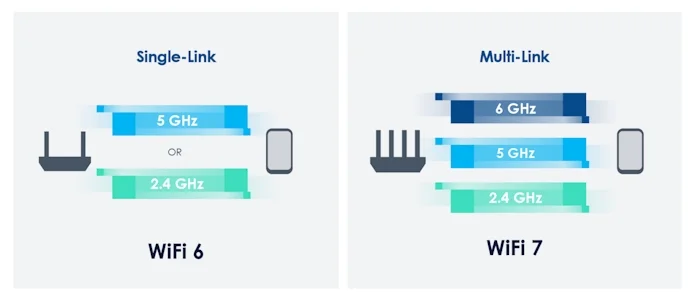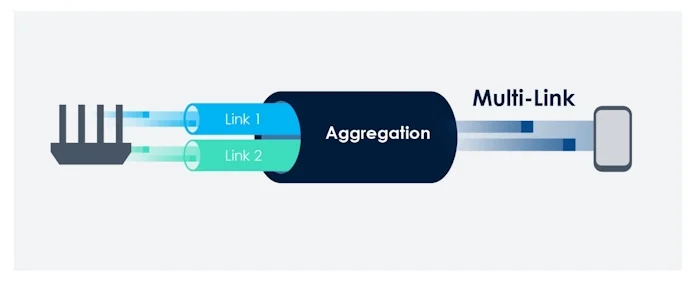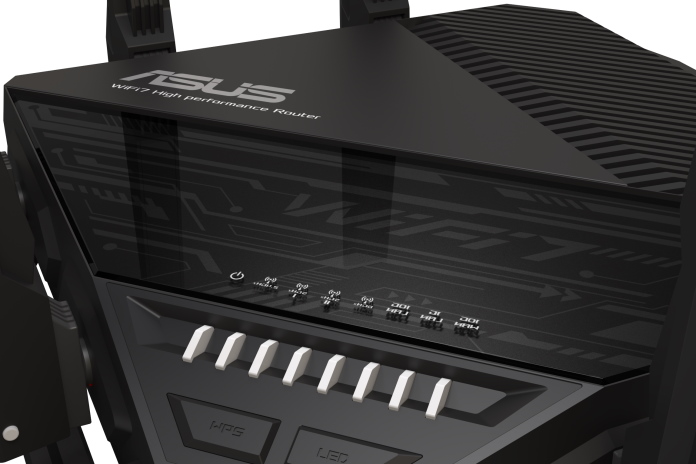We’ve announced our first WiFi 7 routers and our first WiFi 7 motherboards, and we’re ready to make some big claims about what the next-gen wireless standard has to offer today’s connected homes and businesses. Wifi 7 kicks into high gear with new features that deliver faster wireless speeds than ever, all while retaining or refining the advantages of WiFi 6. One of the major upgrades that comes with WiFi 7 is Multi-Link Operation (MLO). Here, we’ll take a deep dive into this revolutionary feature, taking a close look at how it’s poised to offer you faster wireless connections than you’ve ever had before.
What is Multi-Link Operation?
At a high level, Multi-Link Operation (MLO) offers three primary benefits to users:
- It highly increases throughput and reduces latency.
- It allows a single device (client) to concurrently use multiple bands and connections (2.4 GHz, 5 GHz, 6 GHz) and quickly switch between them.
- It allows a router or access point (AP) to transmit and receive packets simultaneously through any available connection.
How WiFi 7 devices use MLO

With earlier standards like WiFi 6 and 6E, your devices connected to your wireless router through one band: either the 5 GHz or 2.4 GHz band with WiFi 6, or the freshly opened 6 GHz band with WiFI 6E. MLO offers higher throughput by letting clients and access points (APs) use more than one band simultaneously.

MLO works differently for clients and APs. MLO allows clients like smartphones and laptops to concurrently transmit data using two bands. A device that supports MLO is free to use these bands at the same time to raise throughput.

At times, minimizing latency is more important to your networking experience than increasing throughput. MLO allows clients to quickly alternate between different bands for lower latency.
How WiFi 7 access points use MLO
Multi-Link Operation is more than a powerful feature for your internet-connected devices — it empowers your WiFi 7 access points and mesh nodes, as well. MLO provides the capability to transmit and receive data simultaneously across multiple links. Such a device will be able to use up to three radios at a time, depending on how many it comes with. This not only highly increases throughput, but it also reduces latency by transmitting data across multiple links to prevent interruptions.

If you are using a mesh network, MLO could also improve the reliability of backhaul connection between access points. In the past, WiFi 6 and 6E backhauls were limited to specific bands; a tri-band router, for example, might use the second 5 GHz band as a backhaul. If this band encountered signal interference or blockage, internet speeds would be degraded due to the reconstruction process of the backhaul. With MLO, backhauls can switch freely between bands to provide a reliable network, even if the original band is down.
MLO has many transmission modes, such as Simultaneous Transceiver Reception (STR), Non-Simultaneous Transceiver Reception (NSTR), Multi-Link Multi-Radio Reception (MLMR), and Multi-Link Single-Radio Reception (MLSR). And complicated types require more sophisticated hardware support. Without getting too technical, these modes can all achieve multi-link operation, but the actual use case will vary according to the available hardware and other technical concerns.
Multi-Link Operation enables new wireless experiences
Looking at the horizon of emerging digital experiences, it’s clear that data transmission requirements for everyday users and businesses alike are only going to increase. With the capability and reliability of WiFi 7 routers and devices, you could experience the kinds of online virtual experiences that previous generations could only dream of.

MLO is also poised to be a game-changer for high-tech businesses, as well. We now require more communication from the cloud to IoT devices, and massive data transmissions between pieces of IoT equipment. MLO could provide rapid and reliable connections at each site as needed.
For both homes and businesses, we’re connecting more devices than ever to our networks — and running applications that demand more bandwidth than ever. With key technologies like Multi-Link Operation, WiFi 7 is equipped to future-proof your network.
Getting started with WiFi 7
As with every generation of WiFi technology, you’ll need both a WiFi 7 router and WiFi 7-compatible devices to take full advantage of everything that the new standard has to offer. It’s early days for the new standard, but we’ve already announced our first WiFi 7 routers: the ROG Rapture GT-BE98 and the ASUS RT-BE96U. Additionally, we’ve pulled back the curtain on our first motherboards with WiFi 7 support. We have many more announcements to make regarding WiFi 7 and our product lineup, so use the subscribe tool in the upper right-hand corner of this page to get brief email updates about our latest announcements. Click here to learn even more about WiFi 7.

